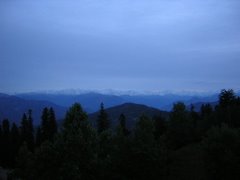I am reproducing below the article by Thomas Friedman in Newyork Times of 20 March. He is one of my favourite American writers sparkling with new theories, ideas and most importantly showing respect for Indians and others...The current article shows the new reality and new hope for Indians...
Quote
Went to a big Washington dinner last week. You know the kind: Large hall; black ties; long dresses. But this was no ordinary dinner. There were 40 guests of honor. So here’s my Sunday news quiz: I’ll give you the names of most of the honorees, and you tell me what dinner I was at. Ready?
Linda Zhou, Alice Wei Zhao, Lori Ying, Angela Yu-Yun Yeung, Lynnelle Lin Ye, Kevin Young Xu, Benjamin Chang Sun, Jane Yoonhae Suh, Katheryn Cheng Shi, Sunanda Sharma, Sarine Gayaneh Shahmirian, Arjun Ranganath Puranik, Raman Venkat Nelakant, Akhil Mathew, Paul Masih Das, David Chienyun Liu, Elisa Bisi Lin, Yifan Li, Lanair Amaad Lett, Ruoyi Jiang, Otana Agape Jakpor, Peter Danming Hu, Yale Wang Fan, Yuval Yaacov Calev, Levent Alpoge, John Vincenzo Capodilupo and Namrata Anand.
No, sorry, it was not a dinner of the China-India Friendship League. Give up?
O.K. All these kids are American high school students. They were the majority of the 40 finalists in the 2010 Intel Science Talent Search, which, through a national contest, identifies and honors the top math and science high school students in America, based on their solutions to scientific problems. The awards dinner was Tuesday, and, as you can see from the above list, most finalists hailed from immigrant families, largely from Asia.
Indeed, if you need any more convincing about the virtues of immigration, just come to the Intel science finals. I am a pro-immigration fanatic. I think keeping a constant flow of legal immigrants into our country — whether they wear blue collars or lab coats — is the key to keeping us ahead of China. Because when you mix all of these energetic, high-aspiring people with a democratic system and free markets, magic happens. If we hope to keep that magic, we need immigration reform that guarantees that we will always attract and retain, in an orderly fashion, the world’s first-round aspirational and intellectual draft choices.
This isn’t complicated. In today’s wired world, the most important economic competition is no longer between countries or companies. The most important economic competition is actually between you and your own imagination. Because what your kids imagine, they can now act on farther, faster, cheaper than ever before — as individuals. Today, just about everything is becoming a commodity, except imagination, except the ability to spark new ideas.
If I just have the spark of an idea now, I can get a designer in Taiwan to design it. I can get a factory in China to produce a prototype. I can get a factory in Vietnam to mass manufacture it. I can use Amazon.com to handle fulfillment. I can use freelancer.com to find someone to do my logo and manage my backroom. And I can do all this at incredibly low prices. The one thing that is not a commodity and never will be is that spark of an idea. And this Intel dinner was all about our best sparklers.
Before the dinner started, each contestant stood by a storyboard explaining their specific project. Namrata Anand, a 17-year-old from the Harker School in California, patiently explained to me her research, which used spectral analysis and other data to expose information about the chemical enrichment history of “Andromeda Galaxy.” I did not understand a word she said, but I sure caught the gleam in her eye.
My favorite chat, though, was with Amanda Alonzo, a 30-year-old biology teacher at Lynbrook High School in San Jose, Calif. She had taught two of the finalists. When I asked her the secret, she said it was the resources provided by her school, extremely “supportive parents” and a grant from Intel that let her spend part of each day inspiring and preparing students to enter this contest. Then she told me this: Local San Jose realtors are running ads in newspapers in China and India telling potential immigrants to “buy a home” in her Lynbrook school district because it produced “two Intel science winners.”
Seriously, ESPN or MTV should broadcast the Intel finals live. All of the 40 finalists are introduced, with little stories about their lives and aspirations. Then the winners of the nine best projects are announced. And finally, with great drama, the overall winner of the $100,000 award for the best project of the 40 is identified. This year it was Erika Alden DeBenedictis of New Mexico for developing a software navigation system that would enable spacecraft to more efficiently “travel through the solar system.” After her name was called, she was swarmed by her fellow competitor-geeks.
Gotta say, it was the most inspiring evening I’ve had in D.C. in 20 years. It left me thinking, “If we can just get a few things right — immigration, education standards, bandwidth, fiscal policy — maybe we’ll be O.K.” It left me feeling that maybe Alice Wei Zhao of North High School in Sheboygan, Wis., chosen by her fellow finalists to be their spokeswoman, was right when she told the audience: “Don’t sweat about the problems our generation will have to deal with. Believe me, our future is in good hands.”
As long as we don’t shut our doors.
 It was the 4th time the Snow Golf tournament was organised in Cerro Castor ski resort. It is in Ushuaia, the southernmost city and also called as End of the World (Fin del Mundo).
It was the 4th time the Snow Golf tournament was organised in Cerro Castor ski resort. It is in Ushuaia, the southernmost city and also called as End of the World (Fin del Mundo).








